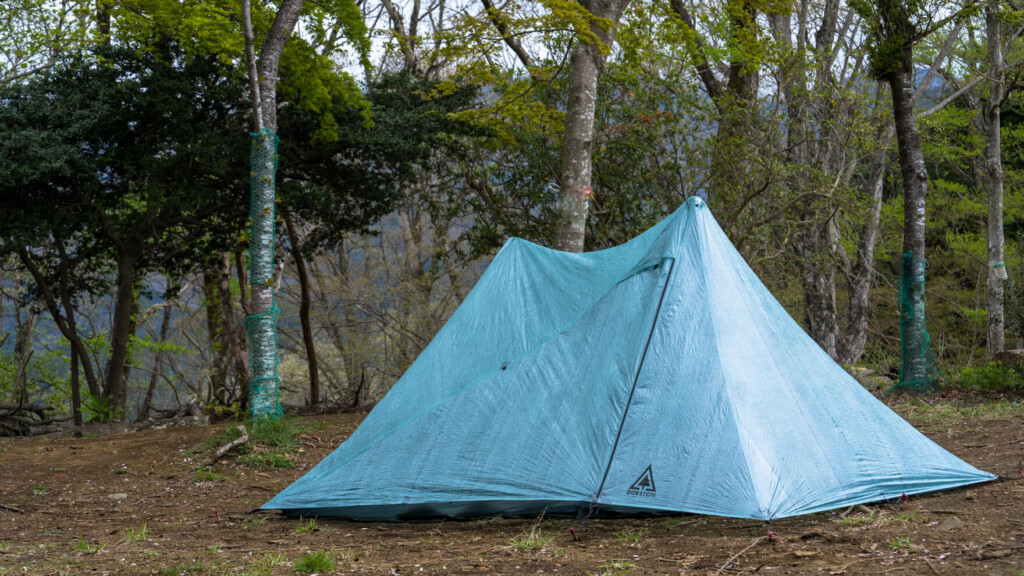
[Not for the self-paying review] DURSTON X-Mid Pro 1 The next-generation lightweight tent (shelter) is innovating with the storm of praise around the world.
It's light, strong, and comfortable. The evolution of lightweight tents (shelters) for mountains is still unstoppable
It's not an exaggeration to say that it's the most popular among today's UL hikers, especially in the West, and now we've finally managed to try out DURSTON GEAR X-Mid Pro 1 This tent is a symbolic item that has made the name of the brand "DURSTON GEAR," launched by Dan Durston, a charismatic figure from the community site (Backpacking Light), where North American fanatics gather, and is a product that can be said to be a masterpiece. It was in the US home country that it was completed immediately upon release and was not available at all, but one winter day I was lucky enough to get it after an email saying that it had resumed sales.
So this time, we'll be reviewing these highly anticipated tents in detail.
table of contents
- Rough features of the DURSTON GEAR X-Mid Pro 1
- Main Specifications and ratings
- Detailed Review - 5+ Why the X-Mid Pro 1 is revolutionary -
- 1: Simple and smart unique geometric design
- 2: Material, storage size, weight - A skillful use of fabrics that are "lightweight, compact, and highly durable" rather than "lightest"
- 3: Ease of setup - Intuitive, easy-to-understand and quick setting
- 4: Weather-resistant - strength in all directions, including rain, wind, and even a certain amount of snow
- 5: The size and comfort of living inside the tent - It's not just spacious, but a comfortable space that you can't see any more -
- Summary: Light enough, extraordinary comfort, robustness, and ease of use. I might not be able to use other shelters for a while.
Rough features of the DURSTON GEAR X-Mid Pro 1
The DURSTON GEAR X-Mid Pro 1 is a single-wall single-person mountain tent made from ultra-lightweight and highly durable DCF (Dyneema composite fabric) material. By accumulating cutting-edge materials, innovative structures, and ingenuity in detail, we have achieved a high level of "easy, comfortable, and robust" with a simple setup that can be set up with at least four pegs, an efficient geometry that provides a spacious living space, comfortable sleeping and livability thanks to the two entrances and exits, and excellent weather resistance that can withstand storms, wind and snow. Though the trekking pole shelter is by no means a one-size style, it is definitely an attractive model for hikers looking for lightweight, strong, and comfortable shelters such as fast packing, through-hiking, and UL hiking.
This is my favorite
- A spacious indoor space for a single-person trekking pole shelter
- Surprisingly easy setup
- An exquisite combination of a light, durable DCF material fly and a strong and compact Sil/PEU nylon floor.
- Moderate breathability and strength to condensation due to double wall side walls etc.
- Excellent weatherability with an eye on the rain, wind and snow
- Convenient pockets and easy-to-use entrances and exits, making it easy to enter and exits, and keeps you in and out.
I'm curious about this
- It's a little compact, but it's still bulkier than an all-fabric tent.
- I want something to hook at the top of the tent
- The height of the bathtub part on the floor feels a little low (though it's not too much of a bother if it can be covered without sagging nicely...)
- Needless to say, since it is a non-independent tent, it is difficult to set up in places where rocks and other fulcrums cannot be removed on the hard ground.
Main Specifications and ratings
| item | Specifications and ratings |
|---|---|
| Number of people to sleep | 1 person |
| weight |
*Actual measurement: 485g |
| Canopy/Fry Material | 0.55 oz Dyneema® Composite Fabric (CT1E.08) in Spruce Green |
| Inner (Floor) Material | 15D Sil/PEU nylon in grey (floor) |
| Zipper material |
|
| pole | Approximately 115-120cm trekking poles |
| Dimensions and area |
|
| Number of doors | 2 |
| Storage size | 30 x 10 cm |
| Floor area | 1.9 m2 |
| Front room area | 2 m2 (1 m2 x 2) |
| accessories |
|
| Living comfort | ★★★★★ |
| Ease of setup and removal | ★★★★★ |
| Weather Resistant | ★★★★☆ |
| Durability | ★★★★★ |
| weight | ★★★★☆ |
| Portability | ★★★☆☆ |
| Versatility | ★★★★★ |
Detailed Review - 5+ Why the X-Mid Pro 1 is revolutionary -
1: Simple and smart unique geometric design
The ultimate expression of the uniqueness of the X-Mid Pro 1 (or more precisely its base model, X-Mid), is its smart design (structure). Designed by Dan Durston, founder of Durston Gear and designer of X-Mid. Originally from Golden, British Columbia, he is a biologist and avid hiker, completes Pacific Crest Trail (4,265km total) and Great Divide Trail (1,200km total), and is also the "fastest finisher" five times in Montana's adventure race "The Bob Marshall Wilderness Open," and is also a recognised online as a genuine tool nerd.
For a long time, he believed that many of the tents supported by trekking poles were unable to overcome the following "trade-off between comfort, ease of construction (weight) and weather resistance" relationship:
- One pole's simple rectangular-based construction makes it the lightest possible, but the comfort of the living space is inferior to other shapes (as the pole occupys the center of the room and the highest area).
- The polygonal structure of one pole is more livable, but the increased number of sides requires more pegs, making it more complicated than a rectangular base in terms of weight and ease of construction.
- Even if you try to increase your livability with two poles on a rectangular base (like a classic pup tent ), vertical walls may reduce wind resistance, or (like the Zpacks Duplex Tent), there is still a pole in the center of the entrance that makes it difficult to enter and exit, and many gigs and pegs are required to set up.
In other words, his ideal image of trekking pole shelter is simply "a simple rectangular structure that requires no need to carry multiple pegs, making it a light, strong, spacious and comfortable tent." Durstone says that this dreamy X-Mid design concept came to mind while hiking the Canadian Rockies on the Great Divide Trail.

The grey parallelogram part provides floor space. The rectangle in the center represents a mat.
Since you cannot place two poles on either end (this will make the sidewalls vertical and require a guyline), you cannot place them near the center of the tent (the poles will occupy the highest position of the tent, and you will have to place the poles inside the room), you will start with the realization that they must be placed approximately halfway between the center and the sidewall. In other words, the poles are placed diagonally on the floor of the tent. This patented layout provides a rich living space without the poles getting in the way of doors and living spaces, and without complicating setup. It is a spacious shelter, yet easily set up without just four pegs and a geeline. In this layout, the vestibule space is located next to the door rather than blocking the door, creating a more usable front yard on both sides. *Quoted from durstongear.com
The new design lies in the fact that it combines the good points of both: the ease of building a "single pole pyramid tent" and the weatherability and the high livability of a "dual pole tent." With two large entrances and exits and an vestibule, without vertical walls, and easy to build with just four pegs, the X-Mid, a simple, lightweight, compact rectangular tent that has been successfully minimized to concede previously lightweight shelters have inevitably made.
2: Material, storage size, weight - A skillful use of fabrics that are "lightweight, compact, and highly durable" rather than "lightest"
To some extent, the disadvantage of "Dyneema is bulky" is overcome to some extent.
The DCF (Dyneema Composite Fabric) material used in the fly part of the tent is extremely durable despite being ultra-lightweight, has many ideal features for tents, such as being almost 100% waterproof, not slack even when wet, and is UV resistant, and is widely used by a variety of manufacturers as a material for high-end, ultra-light tents. It goes without saying that its track record is an example, and it has become a well-known material, so it can't be imagined as a lighter and more durable fabric at this point. However, the X-mid Pro 1 is not simply made from this high-quality material. In fact, this tent uses a hybrid structure that uses two types of materials, Dyneema and nylon, in the right place.
One of the biggest reasons for using two different types of materials is to overcome the difficulty of compressing, one of the most common disadvantages of DCF materials. The major drawback of Dyneema tents is that they are quite lighter than regular tents, but when folded, they are surprisingly small and not all at once. Therefore, by making the floor material of the X-Mid pro 1 15 denier nylon (silicon and highly durable PEU processing) rather than Dyneema, we have achieved a lightweight tent that is as low as possible (despite the Dyneema) and is also able to achieve a lightweight tent that is resistant to opening holes. The photo below compares the X-mid Pro 1 with the Zpacks Plex Solo Tent, which is made entirely of Dyneema fabric, with the same one-person use and floor. Of course, both are larger than nylon and 100% polyester shelters, but despite being larger than the Zpacks in residential space, the X-Mid pro 1 is quite compact.
Does 15 denier nylon have no problem with strength? For that,
15 denier nylon fabric was chosen for the floor, with the idea that if reasonable precautions were taken in the campsite selection, footprints would not be necessary in most circumstances. This 15 denier nylon floor weighs the same, but is much less bulky, and is highly abrasion resistant and waterproof in the long term (DCF has the property of being more likely to wear in the long term than nylon), so I think it's a better option.
says Dan. In fact, it has become common for lightweight tents from major manufacturers recently (such as MSR and NEMO) to use 15D nylon fabric on the floor, so you can see that this tent is not the only one that uses extremely thin and poor materials to reduce weight.
*Of course, we recommend that hikers who use them in conditions where there is a high possibility of puncture (such as rocks and gravel terrain) bring a separate footprint.
What's more, smartly, this nylon is used only on the floor, making it almost no longer bothersome to nylon's weaknesses, such as "sucking water and sagging easily, and being vulnerable to ultraviolet rays." Plus, it's a great thing to do with the inclusion of relatively inexpensive nylon, which saves expensive DCF and reduces costs.
The only factory-made fabric adhesives made in the world, using no seams and tape treatment.
And the most delicate point in the shelter is not made, and the "stitches" are completely tape-treated without sewing (photo below). This is said to be possible through the latest adhesive process developed at a tent production factory in China that can sew DCFs in high quality (here is, it is used by Locus Gear, Samaya, TarpTent, Big Agnes, and several other premium tent manufacturers).
It's not the lightest, but it's quite light
If you look at the main unit alone, the X-Mid pro 1 is not the lightest tent on the market. However, as mentioned above, this is the result of taking into consideration other aspects such as storage and livability, and even if the weight of the main unit becomes a little heavier, the difference is negligible in that it can be reduced in number of pegs, so overall, this is considered a very lightweight tent that is reasonable.
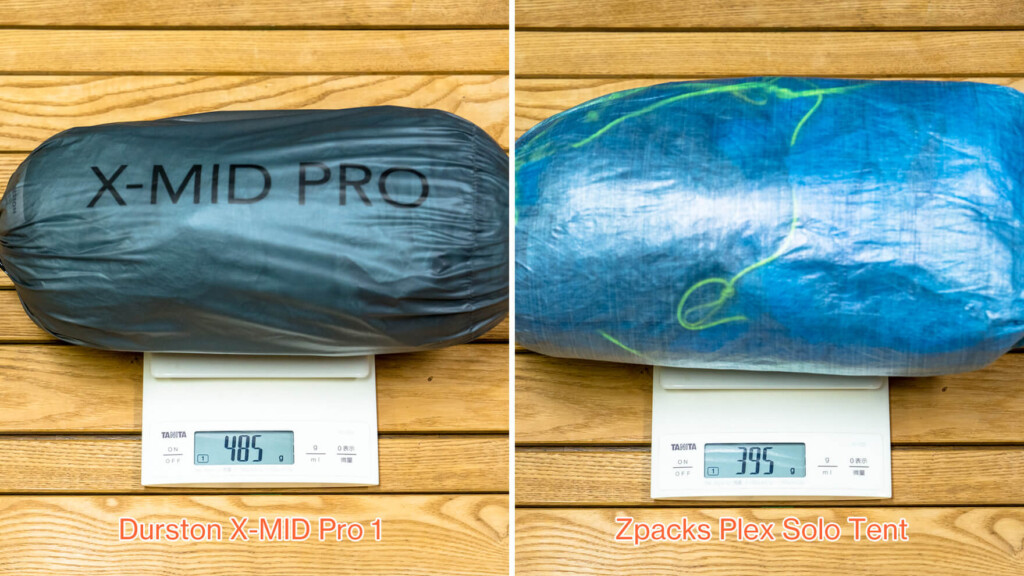
Weight comparison with the lightest class Plex Solo Tent (right) with a trekking pole shelter (with floor). Pegs not included.
3: Ease of setup - Intuitive, easy-to-understand and quick setting
Most trekking pole shelters require at least 6 to 8 pegs to set up, but generally four pegs are required to set up an X-Mid Pro . The setting procedure is basically very simple. First, fix the four corners temporarily with pegs, and then launch the trekking poles at the two vertices through ventilation holes. This is really the only thing you can build (photo below). Once you get used to it, you can set up this tent in just a few minutes without having to re-adjust the temporary fixing pegs.
Of course, until you get used to it, there is a bit of need to move the position of the pegs and adjust the tension of the guyline, but the simple rectangular shape means you won't have to make the subtle adjustments that are common with polygonal tents. This makes it easy to build with a worn-out body without getting frustrated even in rough weather or near darkness, and without getting wet inside the tent. This commitment is something that comes from knowing how grateful this is.
Reference: Pitching is shown from the official video (video below).
4: Weather-resistant - strength in all directions, including rain, wind, and even a certain amount of snow
Despite being such a lightweight and simple tent, we have taken great care to ensure safety and comfort in the event of a stormy weather.
For example, the angle of the walls on each side of the tent. Dan focused on the trade-off between "The more the slope of the wall, the more the wind will escape, but it is less likely to sway (or have flat areas) and rain and snow fall," and decided on the optimal angle that would not be extreme for both. And his even more particular about how he aligns every side of the tent at the same angle. This is because if one is mixed in a steep angle and the other is flat, it can be difficult in both strong winds and snowy weather.
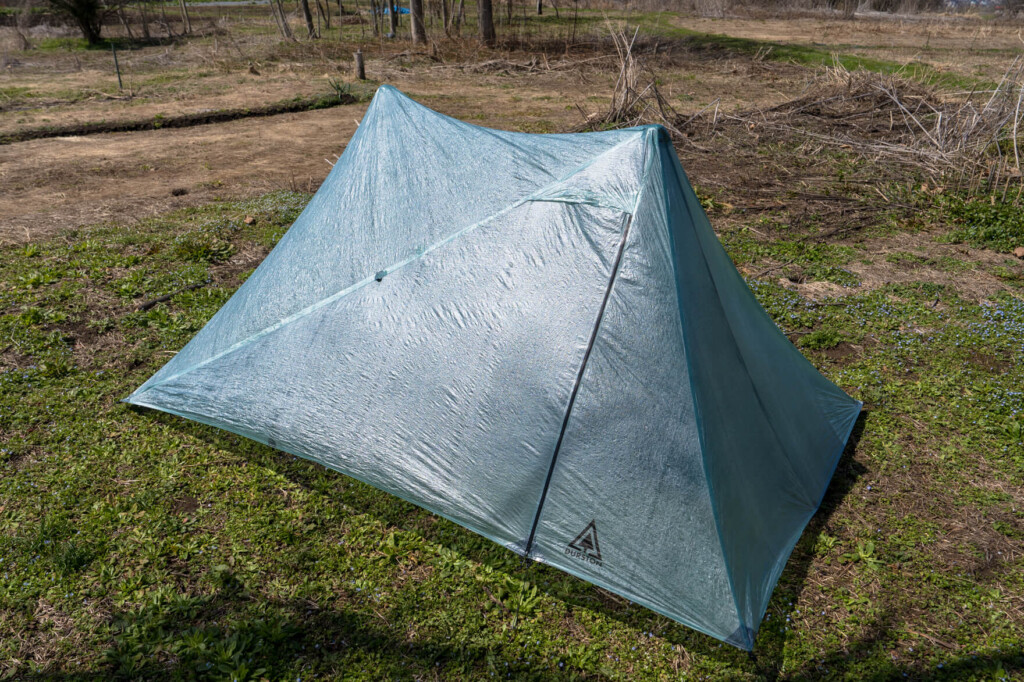
The concept of the X-Mid Pro is that "the wall tilt angle can withstand the wind and easily fall snow, and each side can be aligned at the same angle."
When I first saw this tent, I felt that the walls were a little steep, but as mentioned above, it would be understandable if the design was designed with the 3.5 seasons incorporating a certain amount of snowfall. Of course, in that sense, it is naturally less resistant to wind than other tents with a gentler wall slope. However, in this case, this tent has eight additional stake points around it in addition to the pegs at the four corners, making it safe even in harsh conditions. In particular, stake points are set not only at the slopes but also at the top of the pole, so I personally feel safe even with strong winds. I haven't actually tried this to the limit, but I was able to test it under strong wind conditions of about 10m, so I've captured it in footage (video below).
In addition, it includes Dyneema fabric that does not sagginess even when it rains, full tape seam treatment that you don't need to add yourself, adjusting the length of the pole, and the fly can completely cover the ground, preventing the intrusion of wind, rain splashes, and cold air (of course you can open it to improve ventilation), and there is a proper bathtub that blocks rain splashes (I personally wish it was a little higher), and a vestibule that is spacious enough to keep it open even in light rain, and it can be said to have a more generous and comfortable performance that could not be more comfortable for a trekking pole shelter even in bad weather.

Peak Guyouts, side panel Guyouts, and additional stake points around the base are available to deal with harsh conditions.
5: The size and comfort of living inside the tent - It's not just spacious, but a comfortable space that you can't see any more -
Geometry for outstanding comfort and detailed usability
As I've mentioned a few things up until now, along with the ease of building a tent, the biggest favorite feature of the X-Mid Pro 1 is its extremely livable trekking pole shelter.
The X-Mid pro 1 has a parallelogram floor with a 90-inch base (approx. 230 cm) and a 32-inch vertical height (81 cm) floor as shown below. When laying a sleeping mat, the effective size is 203cm tall and 81cm wide, so even the large person can use it with plenty of room to spare. A regular mat can hold a lot of gear inside the tent, and the parallelogram shape creates a little extra space above your head and under your feet, allowing you to place your luggage there.
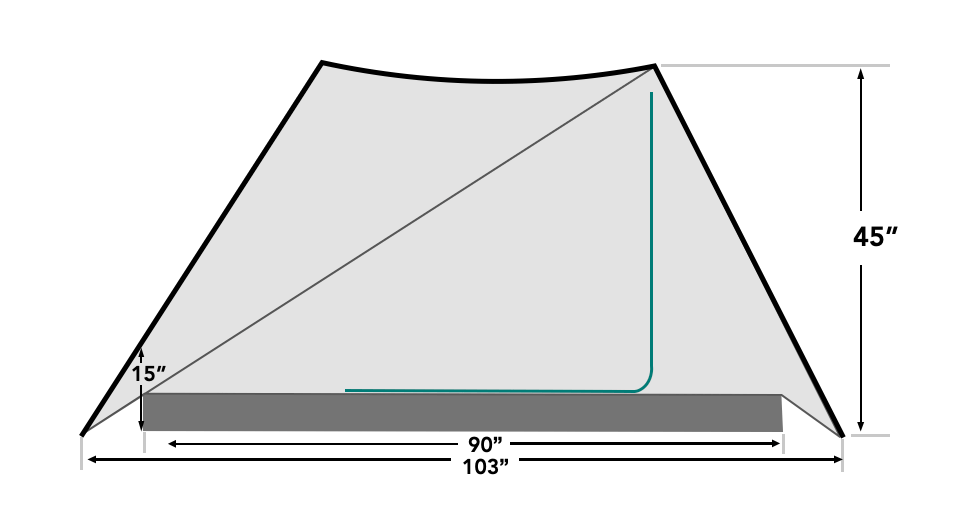

Quoted from the DURSTON official website.
The poles are located at both ends of the floor area and do not interfere with the living space. The diagonal ridges of the two poles maintain a height close to the top, making the headspace spacious. It was about 115cm tall, and my 176cm head never stuttered.
In addition, there is a mesh for insect repellent on the inner layer, and the long sides on the left and right sides have a dual side door structure (photo below). Like most trekking pole shelters, the poles are not located in the middle, making it easy to enter and exit. Again, the slightly offset pole arrangement is lively.
What's even more impressive is this large vestibule (photo below). The two doors mean that these large vestibules are on both sides, so even though I'm not good at organizing, I was completely free from this luxurious space.
The entrance can be closed in the narrow side and only one side can be raised to ventilate. The fly fastening at that time was magnetic. I can only say it's nice.
There are even large pockets on both sides of the inner mesh (photo below). How user-friendly is it? *It's strange why they didn't put anything like a lantern hook at the top even though they were so complete.
Mechanism to keep you comfortable even in rain and condensation
Besides high livability, what is important in terms of comfort of a tent is, of course, ventilation and countermeasures against condensation. Of course, we've taken good measures in that regard. The ventilation (photo below) is attached to the two entrances on the left and right sides, and the gap below the fly allows air to be absorbed, making it breathable. If you want to prevent the cold, you can close the ventilation to block airflow, or adjust the pole to close the fly as well.
What about condensation?
First of all, both sides (long sides) of this tent have a double wall structure made of inner mesh walls and fly, but the top and bottom surfaces (short sides) have a hybrid structure with a single wall structure without mesh, so you should be especially careful about condensation that adheres to the fly on the head and feet. It is covered with mesh fabric, which prevents insects and rain from splashing, and also allows condensation that has arrived inside to be washed down onto the ground outside (photo below. In the case of a single-wall tent, condensation on the inside will flow directly onto the floor).
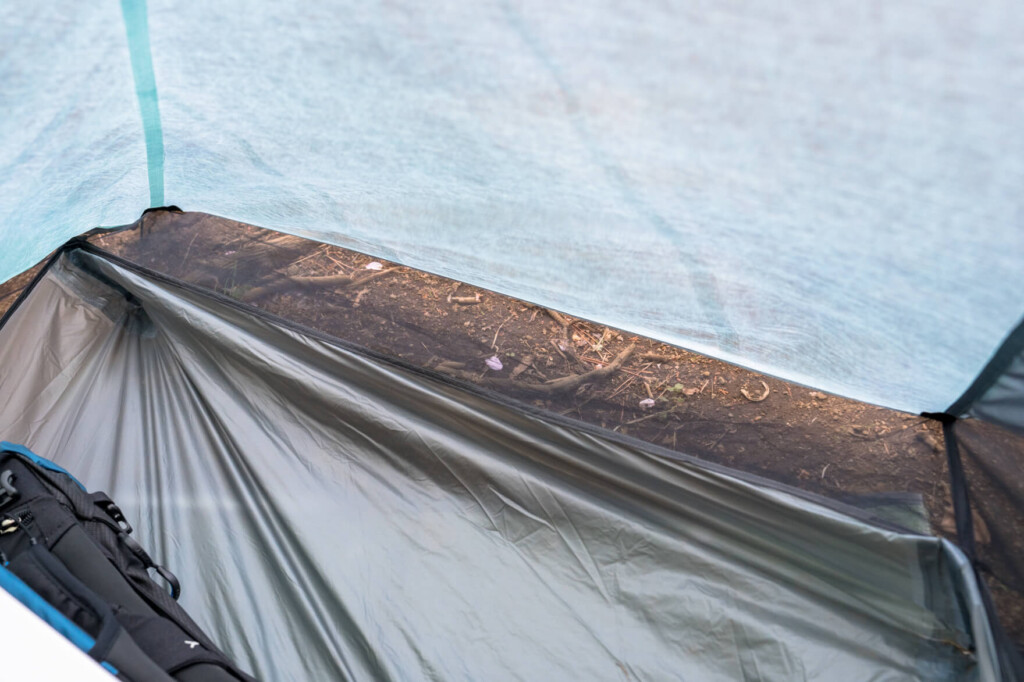
A mesh is stretched between the wall and the floor on the short side of the head and feet, and the water droplets on the inner wall pass through the mesh and fall outside without falling onto the floor.
However, no matter how much ventilation is done, if you try to sleep warmly, there will be some condensation. This time I spent the night during the test in April and found some condensation that was slightly foggy on the window glass (photo below. Is this about the acceptable range).
Those who are concerned about this, what privacy is the extremely thin Dyneema?
Privacy is a common concern about Dyneema's lightweight tents. Because it is made of thin fabric, the inside can be seen a little from the outside, making it vaguely visible silhouettes of the people inside the tent. The photo below shows the inside of the tent. How about it?
You may be able to tell whether it's fluorescent mats or white convenience store plastic bags, but I don't think the rest are clearly visible enough to be so concerned about it. However, each person's feelings differ, so this may be a bit of a negative point for those who are concerned about privacy.
Summary: Light enough, extraordinary comfort, robustness, and ease of use. I might not be able to use other shelters for a while.
Overall, the X-Mid Pro 1 is more spacious and comfortable than any previous trekking pole shelter, user-friendly ease of use, ample weather resistance, compact storage size, and most importantly, light, simple and easy setup. This new, wonderful shelter, which has skillfully sniffed and put together the good points of many of the tent designs that have been around up to now, is a safe bet that it has taken another step further down the long history of mountain tents, which have been well over 100 years.
Up until now, the Zpacks Plex Solo Tent was the number one candidate for this type of shelter, but although this is also a very good tent, once you learn about it, you may still be able to use it a little less. Not only UL hiking and fast packing, but also variations such as stream climbing, bikepacking and camping, anyone who wants lighter than luxury in backcountry, except for harsh winter mountains, will surely be satisfied. Have an exciting and great journey with the X-Mid Pro 1.
*The link below is the e-commerce website in our home country.
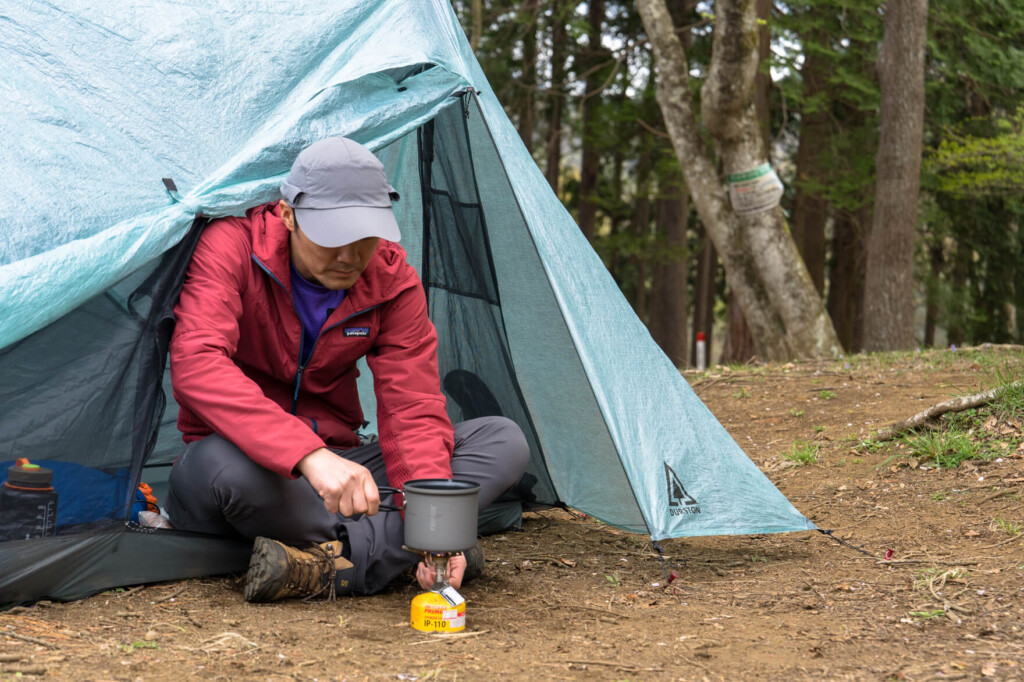
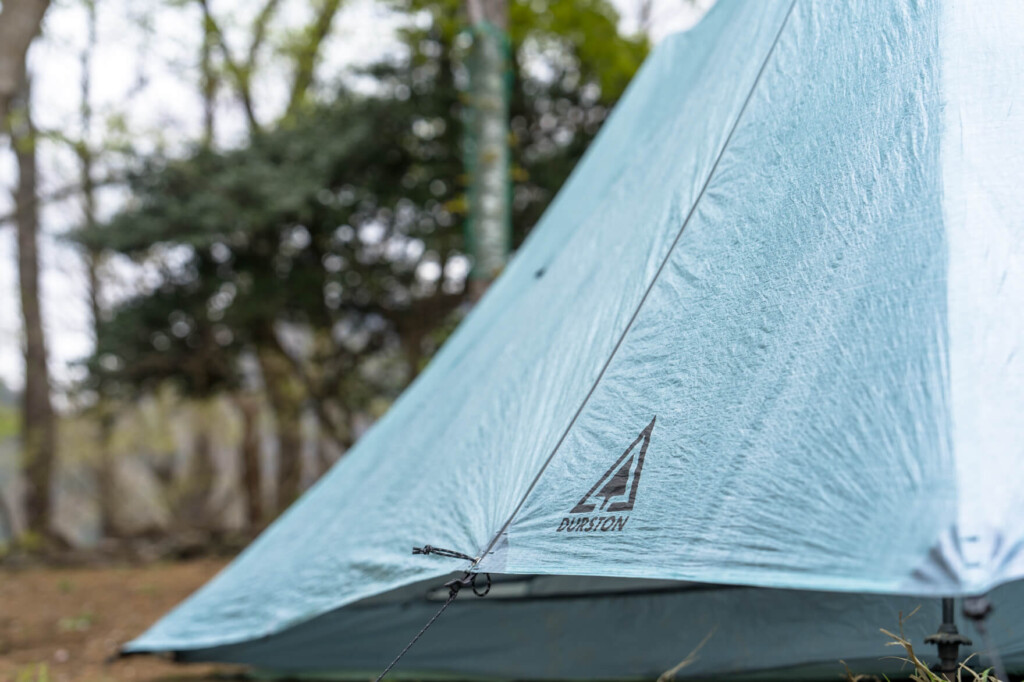
The firm fabric does not sagging even when wet.

As for privacy, you can stick your hands directly to the fly and get this transparent.
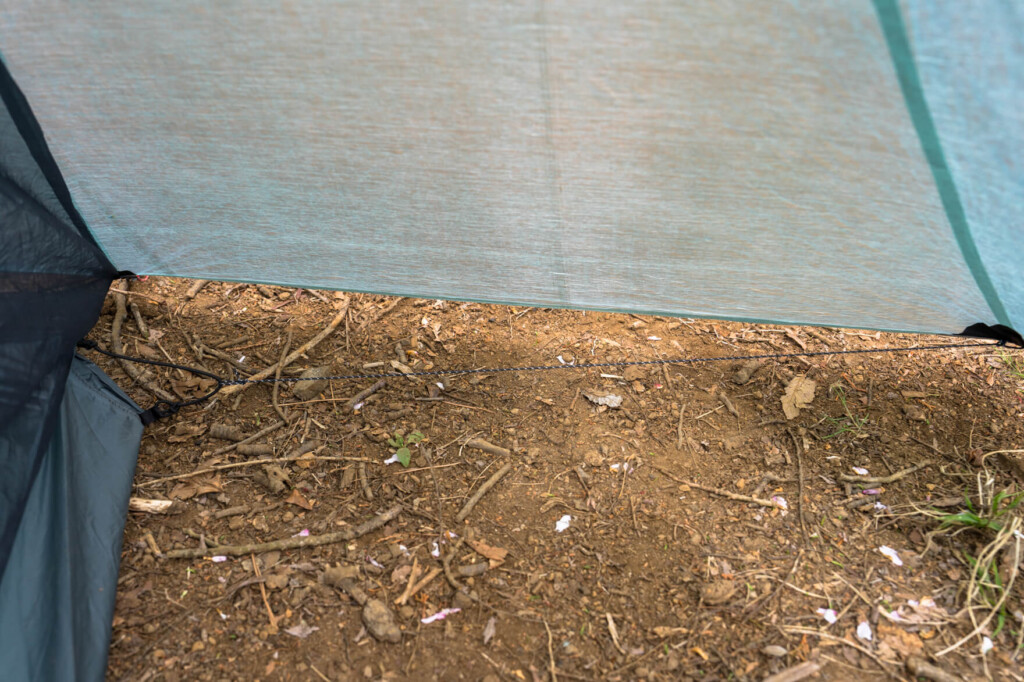
There are connected gaicodes to set up the bathtub and flooring at the four corners.
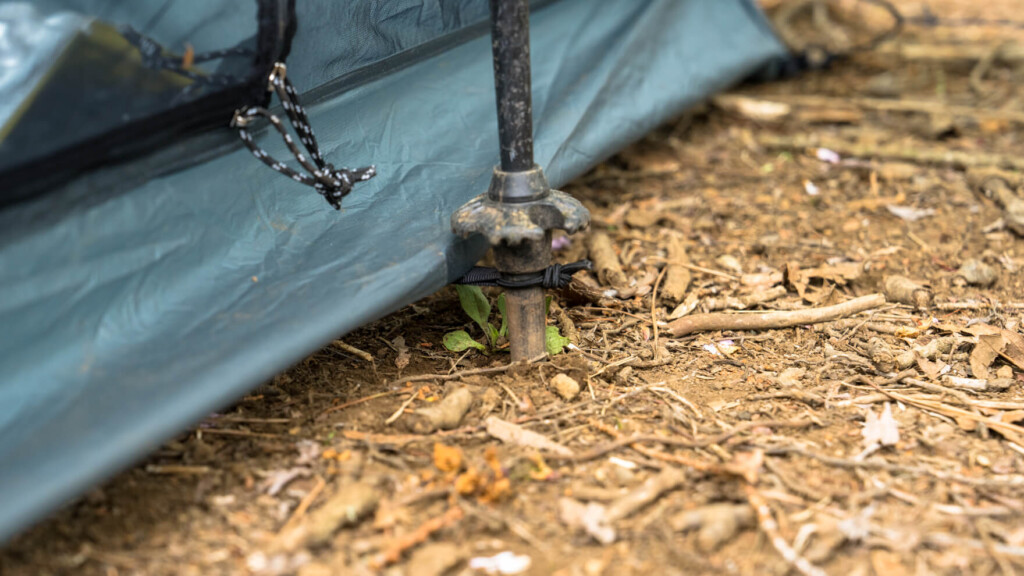
Floor mounted loop for vertical positioning of the trekking pole from the top

Freely adjustable tension
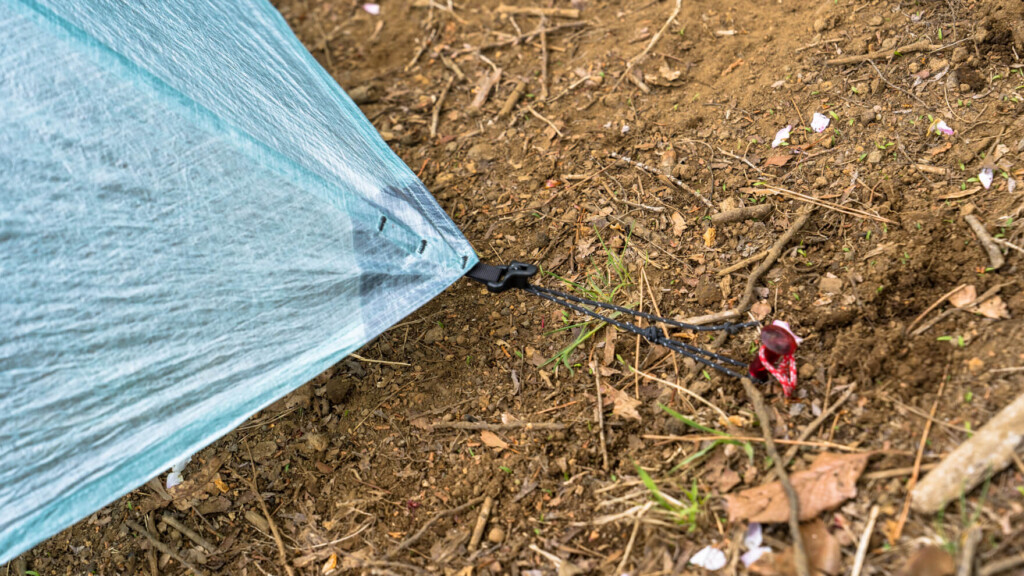
Further reinforcements have been made at the peg points at the four corners.


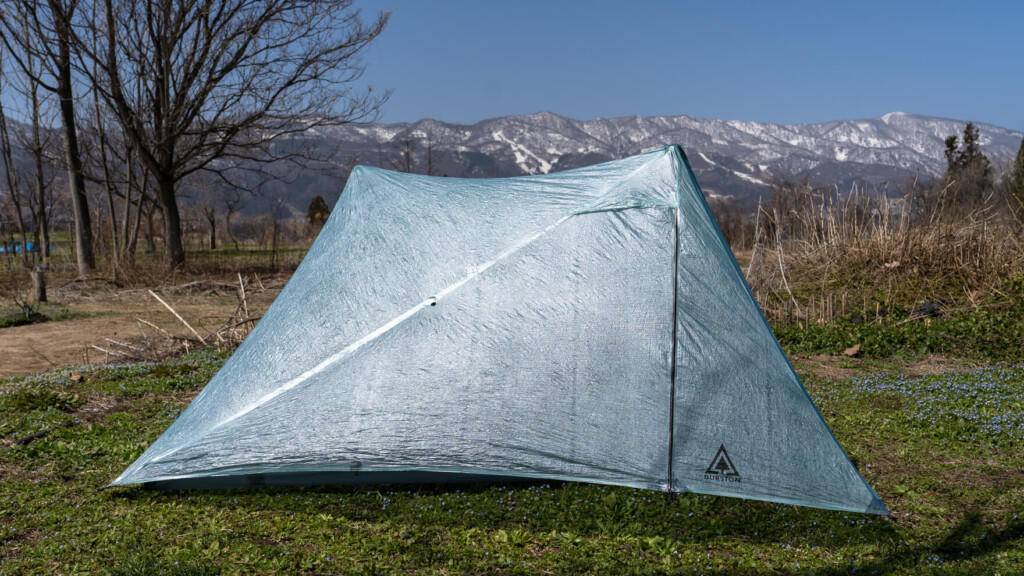
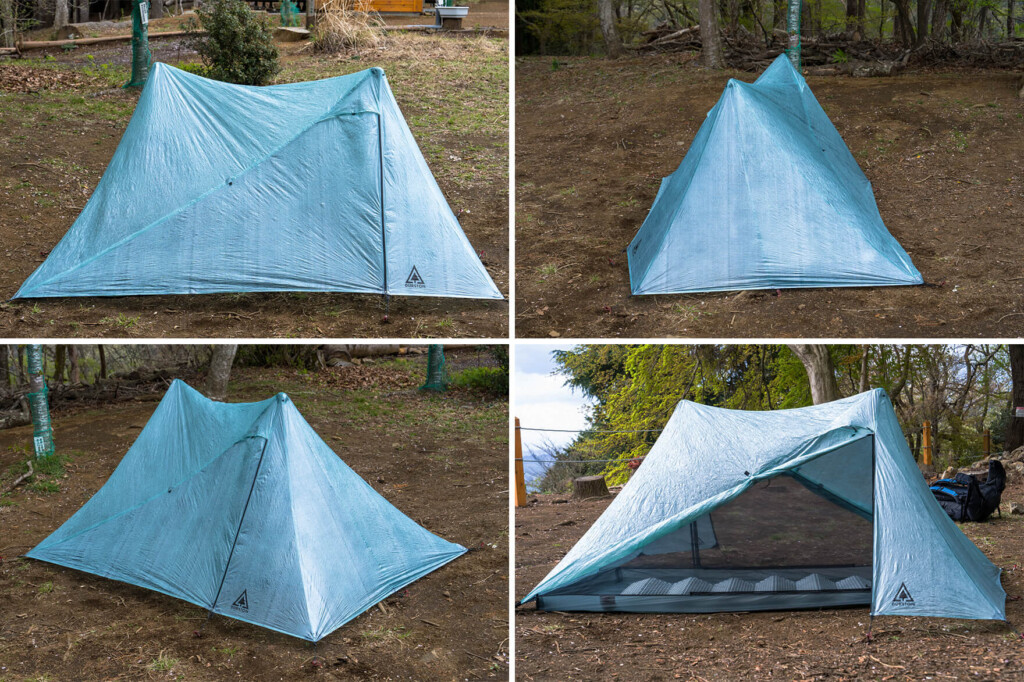

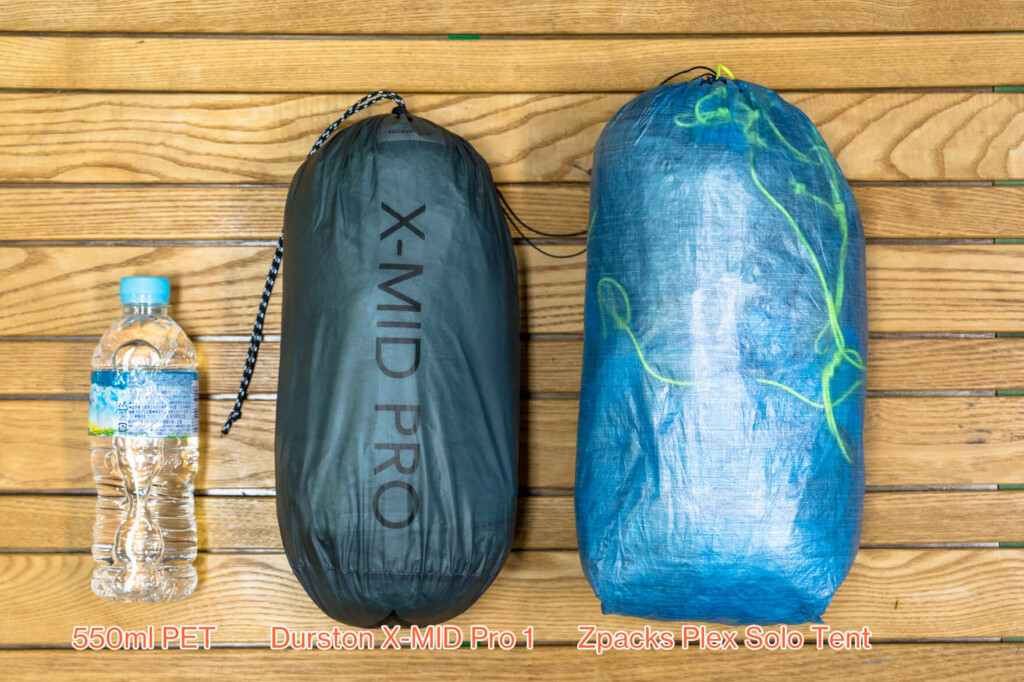
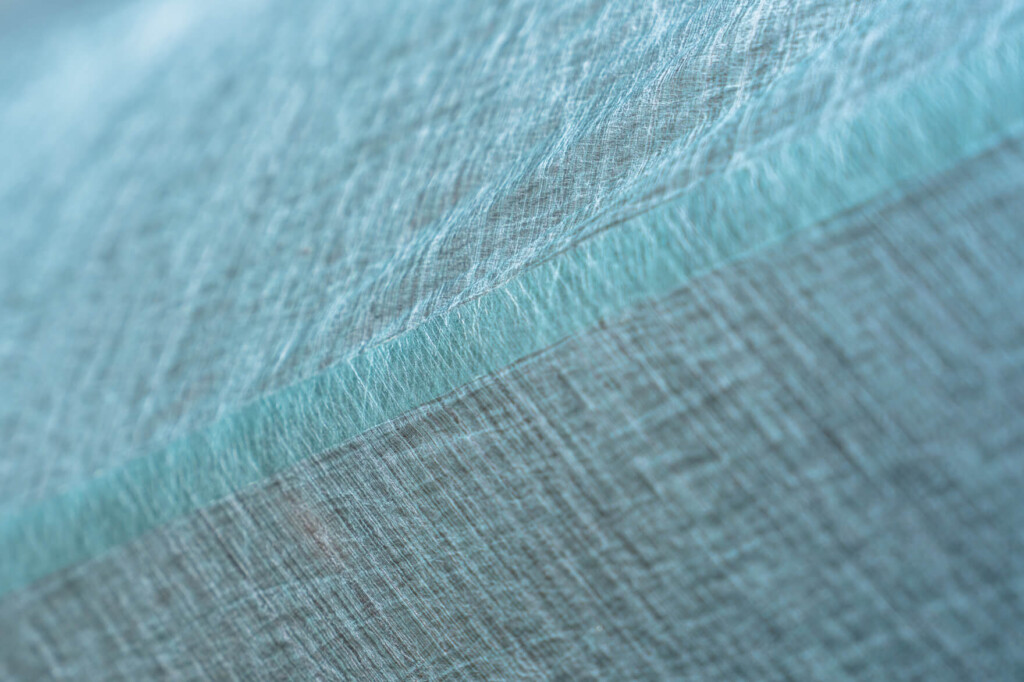
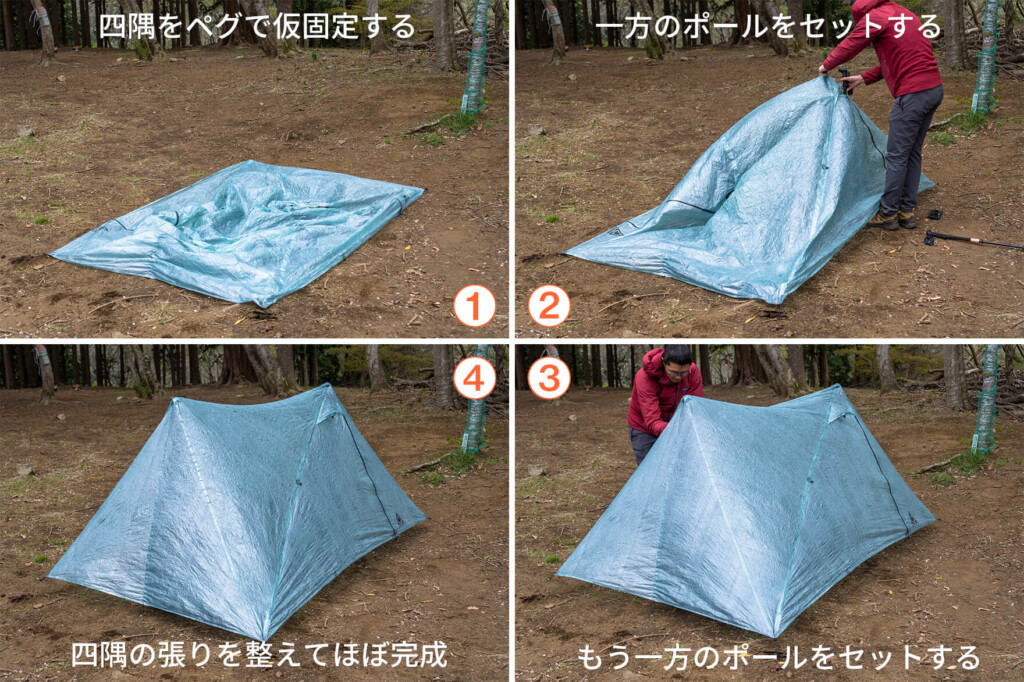
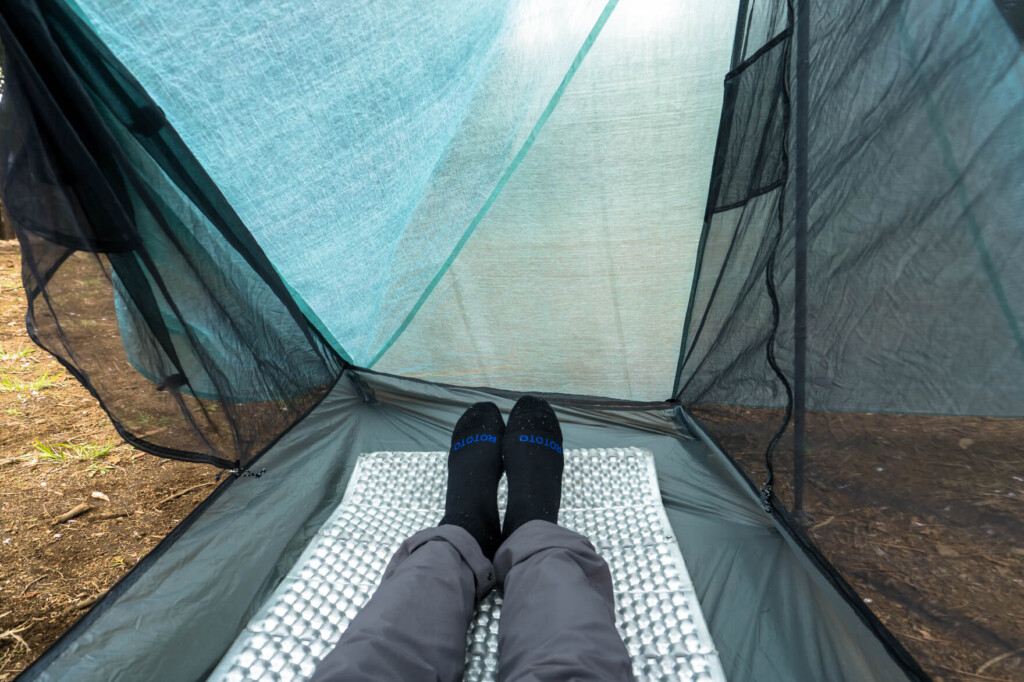
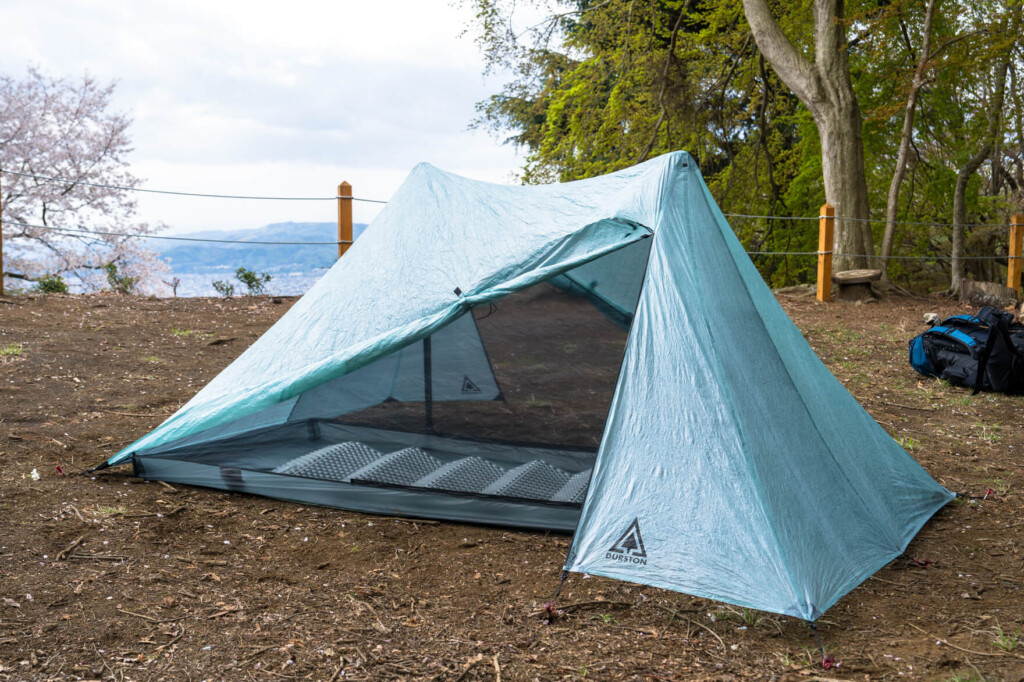
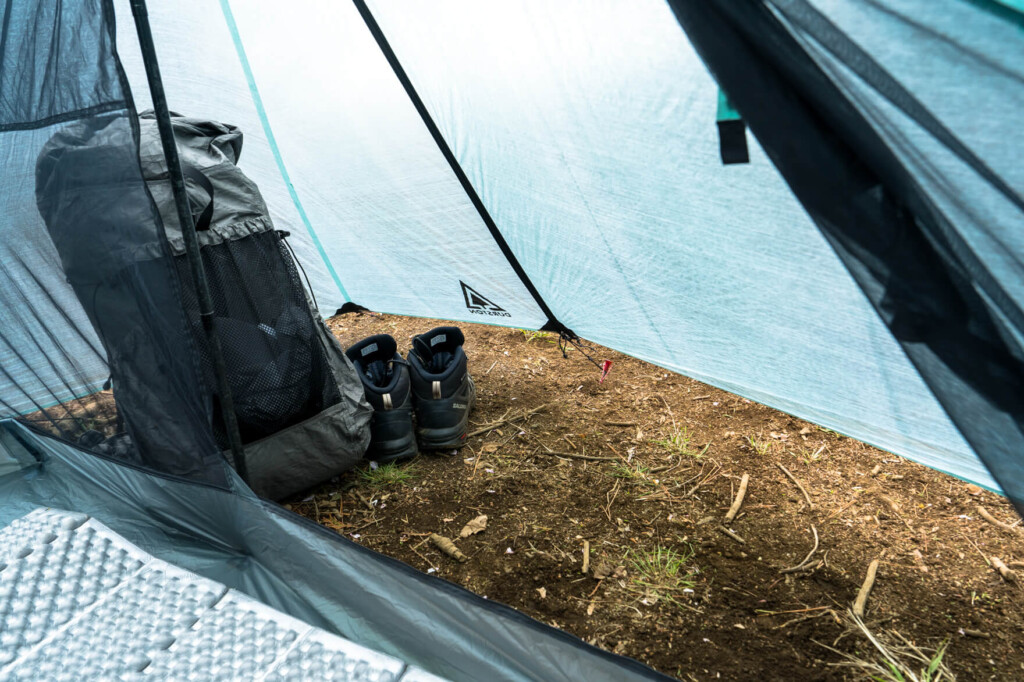
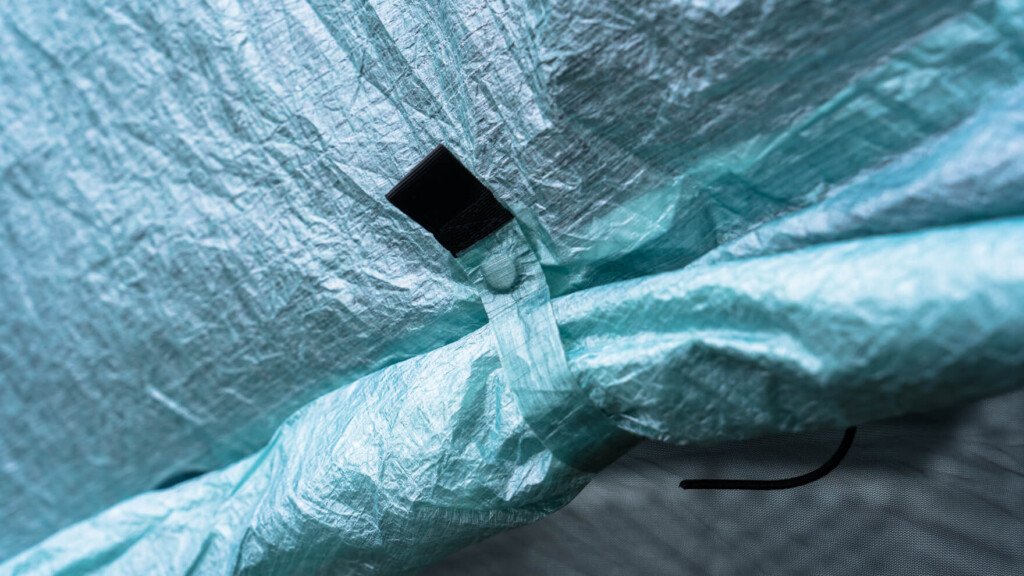

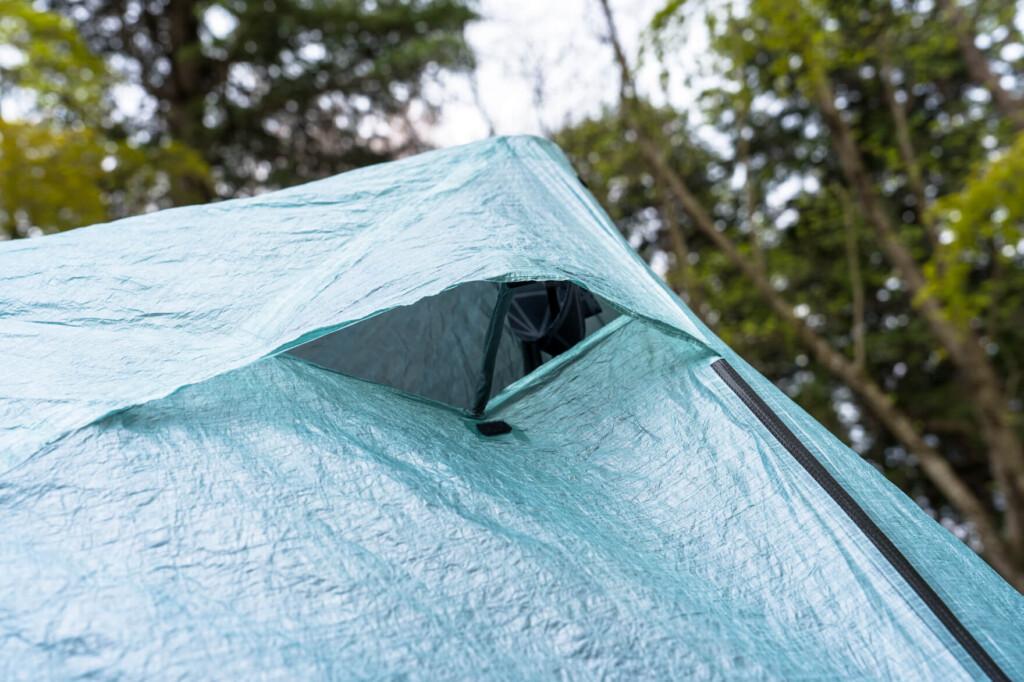

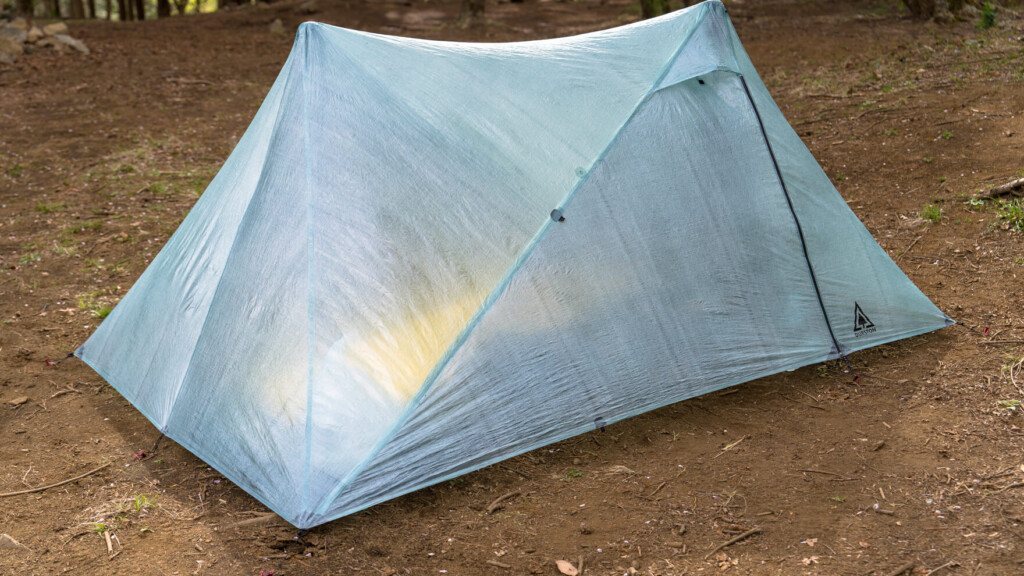
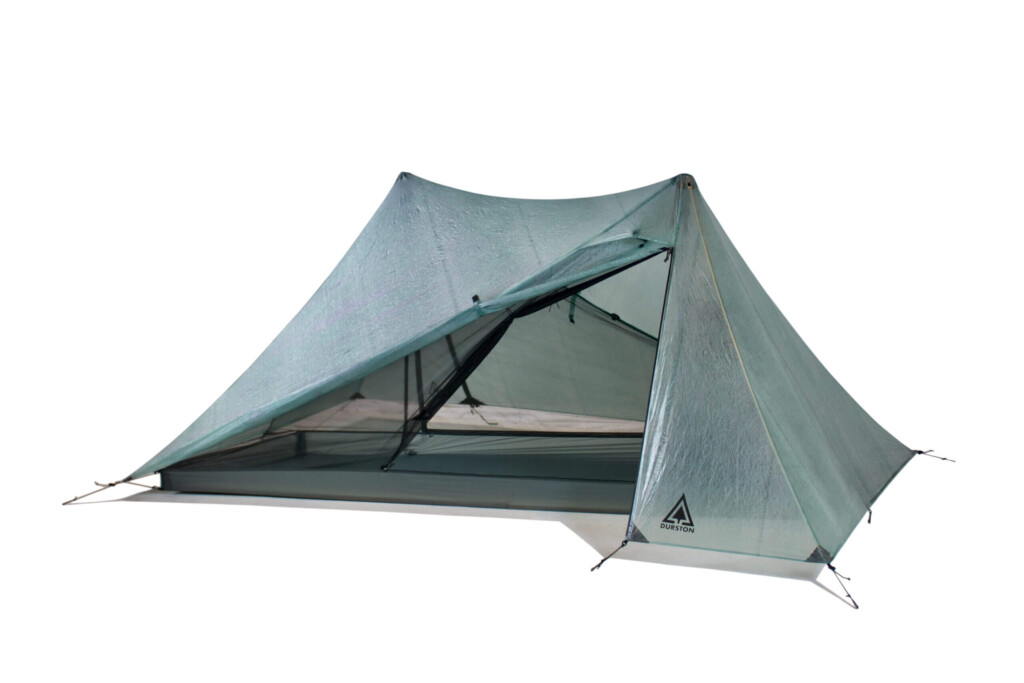
 [A self-paying review without any consideration] DURSTON X-Dome 1+ I'm always impressed by the carefully calculated design. Freestanding double wall tent with livability, portability and weather resistance
[A self-paying review without any consideration] DURSTON X-Dome 1+ I'm always impressed by the carefully calculated design. Freestanding double wall tent with livability, portability and weather resistance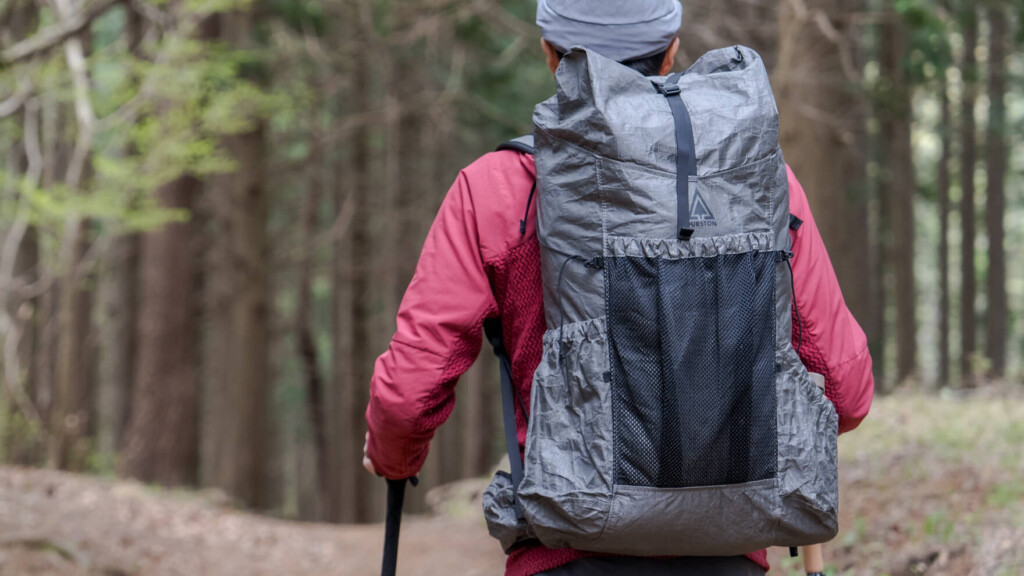 [No self-paying review] DURSTON Kakwa 40 The next-generation hiking backpack, made from the innovative ultra-lightweight, highly durable material "Ultra Fabric", is so perfect that it makes you cry.
[No self-paying review] DURSTON Kakwa 40 The next-generation hiking backpack, made from the innovative ultra-lightweight, highly durable material "Ultra Fabric", is so perfect that it makes you cry. [A self-paying review without any consideration] DURSTON Iceline Trekking Poles: A groundbreaking design that was unlikely to exist. Ultra-lightweight, strong and difficult to break, making it a state-of-the-art trekking pole that is extremely secure
[A self-paying review without any consideration] DURSTON Iceline Trekking Poles: A groundbreaking design that was unlikely to exist. Ultra-lightweight, strong and difficult to break, making it a state-of-the-art trekking pole that is extremely secure [No self-paying review] DURSTON Wapta 30 Overturns the stereotype of traditional frameless backpacks, combining amazing lightness and comfort
[No self-paying review] DURSTON Wapta 30 Overturns the stereotype of traditional frameless backpacks, combining amazing lightness and comfort